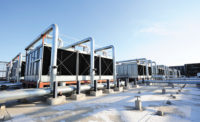In the recent past, you probably attended a virtual lunch-and-learn presentation, read an article, or had a discussion with a controls sales representative in which the topic was a chilled water plant optimization solution that uses some sort of cloud-based machine learning (ML) algorithms. What was your understanding of what optimization means? Similarly, what was your understanding of the ML algorithms that the aforementioned optimization solution used? I have no doubt the discussion was not short of claims (on behalf of the provider of the solution) of energy savings up to 30% and that the solution could probably work with any building automation system (BAS) in both new and existing buildings. Further, the discussion included, at most, very little details about how the energy savings are calculated or the type of machine learning algorithms used and their associated accuracy.
Today’s technological advancements have demonstrated the power of artificial intelligence (AI)-based control algorithms and their positive impact on the environment. However, it’s important to note that, just because a chilled water plant optimization solution is cloud-based and uses ML algorithms, it does not necessarily mean the solution will work as expected. To even begin to differentiate between various cloud-based chilled water plant optimization solutions, one needs to have a fundamental knowledge base about BAS (and their sequences of operation) and ML algorithms. First, one will need to understand that not all ML algorithms use the same type of data, i.e., discrete or continuous. For example and as it relates to building systems, the occupied or unoccupied status of the space throughout the day represents a set of discrete data, while the space temperature throughout the day represents a set of continuous data.
It’s important to note that, in the domain of AI (i.e., computers that can imitate human intellect and behavior), deep learning is a subset of ML, and ML is a subset of AI. Commonly, ML algorithms could be divided into four categories as follows: 1) supervised learning, 2) unsupervised learning, 3) semi-supervised learning, and 4) reinforcement learning.
Some of the most simple chilled water plant optimization packages use supervised learning algorithms. The goal of these algorithms is to model relationships and dependencies between the target prediction output and the input features such that they can predict the output values for new data based on those relationships it learned from the previous data sets. In other words, supervised learning algorithms attempt to fit a function on the existing data and use said function to predict an outcome based on new data. One significant deficiency of this type of algorithm is that it has a hard time extrapolating outside of the range of data that was used to determine the function.
Let’s take, for example, the data shown in Figure 1: A water-cooled chiller manufacturer publishes data that shows the relationship between entering condenser water temperature (ECWT), load on the chiller (LOAD), and the energy consumption expressed in kW/ton. The data is only limited to three ECWT values: 75°F, 80°, and 85°. If we define y as the output of the function (i.e., kW/ton), one could write said function as y = f (ECWT, LOAD). There must be a ML algorithm capable of predicting y based on the actual values of ECWT and LOAD. A method used for comparing the accuracy of ML algorithms is the mean square error (MSE): It is the sum, over all the data points, of the square of the difference between the predicted and actual target variables divided by the number of data points. Another method is the root mean squared error (RMSE), which is the square root of the MSE. MSE is measured in units that are the square of the target variable, while RMSE is measured in the same units as the target variable.
Let us assume the proposed chilled water plant optimization solution uses regression-type ML algorithms to predict the performance of a chiller. Linear regression is a supervised ML algorithm, where the predicted output is continuous and has a constant slope. Figure 2 shows a sample of a linear regression algorithm predicting a linear function. As such, if one uses a linear regression ML algorithm to predict nonlinear data (as shown in Figure 1), most likely the MSE or RMSE will far exceed any reasonable acceptable values (i.e., less than 3%). A 10% RMSE could mean 0.05 kW/ton or more, and, for a plant that has a capacity of 1,000 ton, this RMSE may significantly impact the demand charge the utility company uses when billing the owner.
In regard to predicting the performance of the chiller and in addition to using a more sophisticated AI algorithm (i.e., reinforcement learning or deep learning) to lower the MSE and/or RMSE, one also needs to expand on the number of variables used by the algorithms. Figure 3 shows the minimum amount of variables I recommend using when attempting to predict the performance of a water-cooled chiller. For the algorithm to work as expected, it needs to be trained. This means that, most likely, one needs to operate the chiller plant with standard sequences of operation for a period of time (i.e., about six to 10 weeks) in order to gather enough data to properly train the algorithms.
What makes the AI algorithms so much more powerful when compared with a formula-based approach? After all, when designing an HVAC system, one uses formulas for almost all components of the system; further, the manufacturers provide sufficient information (i.e., pump curves, fan curves, etc.) that one could use, at least theoretically, to predict the performance of the system as a whole and/or of a component of the system. The answer is that formulas are very limited; they only account for a fixed number of variables. For example, it would be significantly challenging to use just the published pump curves to try and operate the pump at its most efficient point; systems effects, sensor accuracy, etc., are latent variables that a typical formula does not account for. Unlike observed/measured variables, latent variables are variables that exist but cannot (easily) be measured and accounted for. Figure 4 shows a potential computational graph for the chiller controls diagram shown in Figure 3. This is where sophisticated AI algorithms (i.e., deep learning) can be relatively more accurate when compared with standard ML algorithms; deep learning or reinforcement learning algorithms tend to be better at accounting for latent variables when making predictions, even if said latent variables are not directly used in the training data. Table 1 shows sample training data that can be used to train an ML algorithm or a deep learning algorithm to predict the energy consumption (expressed in kW) of a chiller.
How does an engineer specify a plant optimization package? Writing a performance spec that reads similar to the chiller water plant optimization solution shall utilize techniques and algorithms that constantly maintain the minimal possible utility cost (electricity, thermal energy and water) for the chiller plant system over a future time horizon, considering the thermal load of the buildings, ambient dry and wet bulb conditions, and electric and thermal utility rate structures are insufficient. The verbiage does not define what minimal possible utility cost really means. Said language gives the provider of the solution the freedom to use low-performing ML algorithms, which may require less time to develop in lieu of high-performing deep learning algorithms. Further, performance verbiage that reads similar to the chilled water plant optimization package shall be capable to determine and optimize chilled water temperature set points, condenser water temperature set points, staging of chillers, water-side economizers and cold storage systems, sequencing and speed control of chilled water and condenser pumps, and sequencing of cooling towers and cooling tower fan speed control are also insufficient in holding the provider of the solution accountable for the performance of the algorithms. The verbiage does not define what capable to determine and optimize means. One could just use an excel formula to comply with this requirement; capable and optimize are not specific enough.
This, in turn, may lead to having an owner paying a significant amount of money for an optimization solution that does not perform as expected and/or desired.
An alternative to the specification verbiage described above is to use more specific language, such as: The chiller water plant optimization solution shall utilize techniques and algorithms that continuously predict the energy performance (i.e., in kW/ton) of the chiller plant system over a future time horizon considering the thermal load of the buildings, ambient dry and wet bulb conditions, and the electric and thermal utility rate structures. Further, the RMSE of each algorithm used to make predictions shall be as follows: 1) No more than 3% for predicting chilled water and condenser water temperatures; 2) No more than 5% when predicting chilled water and condenser water flow; 3) No more than 2% when predicting the kw demand of each chiller; 4) No more than 5% when predicting the energy consumption (in kW/hr) of the tower fans; and 5) No more than 3% when predicting the energy consumption (i.e., in kW/hr) of chilled water and condenser water pumps.
The further strengthens the verbiage described above. One could also include requirements related to 1) continuous (re)training of the algorithms; 2) interval between predictions and communication with the local BAS (i.e., every 5 minutes); and 3) developing new state-of-the-art algorithms at certain time intervals (i.e., every six months).
Even though ASHRAE published Guideline 36, “High Performance Sequences of Operation for HVAC Systems,” sequences of operation, as we have used them for the past decade, will slowly become somewhat obsolete in the next five to 10 years, as said sequences may be used only for gathering data to train algorithms.
As such, engineers will most likely need to adjust and/or improve their knowledge of AI algorithms used for the control of a building system. One will need to have a holistic approach when designing a BAS such that an owner can easily connect a BAS to a cloud-based optimization solution.










